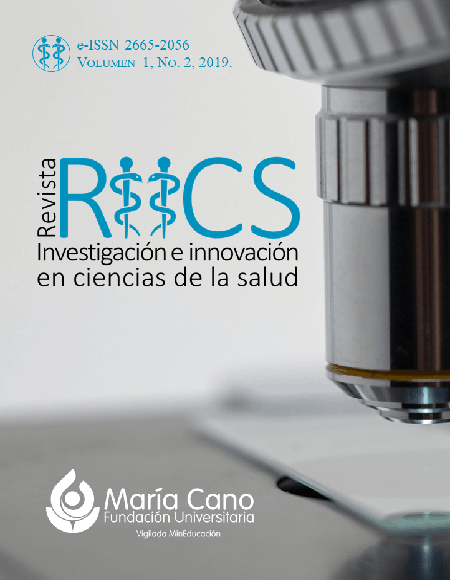Effectiveness of an educational intervention on post cardiac rehabilitation patients for the knowledge and healthy life styles
Efectividad de una intervención educativa en estilos de vida saludables, en el conocimiento y comportamiento en pacientes post-rehabilitación cardiaca
This work is licensed under a Creative Commons Attribution-NonCommercial-NoDerivatives 4.0 International (CC BY-NC-ND 4.0).
Show authors biography
Target: To evaluate the effectiveness of the educational intervention in life styles, in the knowledge and changes in behavior in patients with post-rehabilitation heart disease; Methodology: The investigation is a quantitative experimental study before and after without a control group, with a sample of 20 subjects in phase IV that had finished III phase of rehabilitation, an educational intervention was realized and a previous and a later one measurement of results was applied with monthly evaluation. Results: it was found that p <0.05 for change in the behavior and knowledge, being in behavior of habits of healthy life p 0.0001 to one month after the intervention and in the knowledge p 0.002 immediately after realized; being statistically significant. Conclusion: An educational intervention about the risk factors of heart disease and protective behaviors related to habits of healthy life might increase the knowledge and to change behavior into patients with heart disease in phase IV or that have finished Phase III of cardiac rehabilitation.
Article visits 1293 | PDF visits 524
- Jaramillo C, Gómez E, Hernández E, Saldarriaga C, Flórez N, Buitrago R. Consenso colombiano para el diagnóstico y tratamiento de la insuficiencia cardíaca crónica. Sociedad Colombiana de Cardiología y Cirugía Cardiovascular. 2014.
- Virtanen M, Vahtera J, Singh-Manoux A, Elovainio M, Ferrie JE, Kivimäki M. Unfavorable and favorable changes in modifiable risk factors and incidence of coronary heart disease: The Whitehall II cohort study. International journal of cardiology. 2018; 269: 7-12. https://doi.org/10.1016/j.ijcard.2018.07.005
- Organización Mundial de la Salud. Informe sobre la situación mundial de las enfermedades no transmisibles 2014. 2014.
- Paho Mortality [Internet]. [citado 22 de octubre de 2019]. Disponible en: https://hiss.paho.org/pahosys/grp.php
- Páginas - Enfermedades cardiovasculares [Internet]. [citado 29 de octubre de 2019]. Disponible en: https://www.minsalud.gov.co/salud/publica/PENT/Paginas/enfermedades-cardiovasculares.aspx
- Mortalidad [Internet]. [citado 22 de octubre de 2019]. Disponible en: https://www.dssa.gov.co/index.php/estadisticas/mortalidad
- World Health Organization. Global action plan for the prevention and control of noncommunicable diseases 2013-2020. 2013.
- Marelli A. The Future of Adult Congenital Heart Disease Research: Precision Health Services Delivery for the Next Decade. Canadian Journal of Cardiology. 2019. https://doi.org/10.1016/j.cjca.2019.09.015
- Obiebi IP, Aiwuyo HO. 2017 American College of Cardiology/American Heart Association Clinical Guideline-based Prevalence of Hypertension in a semi-urban community in Nigeria: Public Health Perspective. Revista Colombiana de Cardiología. 2019; 26 (6): 346-53. https://doi.org/10.1016/j.rccar.2019.02.007
- Ministerio de salud y protección social. Plan de Acción para la prevención y control de las enfermedades cardiovasculares 2011-2020 [Internet]. minsalud; 2011. Disponible en: https://www.minsalud.gov.co/salud/Documents/4%20Plan%20de%20Cardiovasculares%20en%20detalles.pdf
- Del Carmen Ortega-Navas M. The use of new technologies as a tool for the promotion of health education. Procedia-Social and Behavioral Sciences. 2017; 237: 23-9. https://doi.org/10.1016/j.sbspro.2017.02.006
- Vest JR, Ben-Assuli O. Prediction of emergency department revisits using area-level social determinants of health measures and health information exchange information. International Journal of Medical Informatics. 2019. https://doi.org/10.1016/j.ijmedinf.2019.06.013
- Ermis A, Melander S. Minimize admissions for heart failure: the need to educate patients and help them make difficult lifestyle changes requires clinicians to think differently and offer novel treatment approaches [Internet]. Clinical Advisor. 2012 [citado 29 de octubre de 2019]. Disponible en: https://link.galegroup.com/apps/doc/A301087177/AONE?sid=lms
- Chiang C-Y, Choi K-C, Ho K-M, Yu S-F. Effectiveness of nurse-led patient-centered care behavioral risk modification on secondary prevention of coronary heart disease: A systematic review. International journal of nursing studies. 2018; 84: 28-39. https://doi.org/10.1016/j.ijnurstu.2018.04.012
- Huynh QL, Whitmore K, Negishi K, Marwick TH, ETHELRED Investigators. Influence of risk on reduction of readmission and death by disease management programs in heart failure. Journal of cardiac failure. 2019; 25 (5): 330-9. https://doi.org/10.1016/j.cardfail.2019.01.015
- Vámosi M, Lauberg A, Borregaard B, Christensen AV, Thrysoee L, Rasmussen TB, et al. Patient-reported outcomes predict high readmission rates among patients with cardiac diagnoses. Findings from the DenHeart study. International journal of cardiology. 2019. https://doi.org/10.1016/j.ijcard.2019.09.046
- Cobos-Carbo A, Augustovski F. Declaración CONSORT 2010: actualización de la lista de comprobación para informar ensayos clínicos aleatorizados de grupos paralelos. Medicina clínica. 2011; 137 (5): 213-5. https://doi.org/10.1016/j.medcli.2010.09.034
- Lange I, Vio F. Guía para Universidades saludables y otras instituciones de Educación Superior. OPS, Universidad Católica de Chile, Universidad de Chile, OMS, OPS, Vida Chile. Santiago: Productora Gráfica Andros; 2006.
- Loaiza DPB, Álvarez CV, Vargas LJ. Validación de contenido y adaptación del cuestionario Fantastico por técnica Delphi. Salud Uninorte. 2015; 31 (2): 214-27. https://doi.org/10.14482/sun.31.2.5583
- Ramírez-Vélez R, Agredo RA. Fiabilidad y validez del instrumento" Fantástico" para medir el estilo de vida en adultos colombianos. Revista de Salud Pública. 2012; 14: 226-37. https://doi.org/10.1590/S0124-00642012000200004
- Mayer O, Cvíčela M, Bruthans J, Gelžinský J, Hronová M, Wohlfahrt P. PO178 The Prospective Study of Education as Additive Mortality Risk Indicator In Chronic Coronary Heart Disease Patients. Global Heart. 2018; 13 (4): 420. https://doi.org/10.1016/j.gheart.2018.09.156
- Karakurt P, Kasimoğlu N, Bahçeli A, Başkan SA, Ağdemir B. The effect of activities of daily living on the self-care agency of patients in a cardiovascular surgery clinic. Journal of Vascular Nursing. 2017; 35 (2): 78-85. https://doi.org/10.1016/j.jvn.2016.10.004
- Benbassat J, Taragin MI. The effect of clinical interventions on hospital readmissions: a meta-review of published meta-analyses. Israel journal of health policy research. 2013; 2 (1): 1. https://doi.org/10.1186/2045-4015-2-1
- Blanc A-L, Fumeaux T, Stirnemann J, Dupuis Lozeron E, Ourhamoune A, Desmeules J, et al. Development of a predictive score for potentially avoidable hospital readmissions for general internal medicine patients. PloS one. 2019; 14 (7): e0219348. https://doi.org/10.1371/journal.pone.0219348
- Peres HA, Pereira LRL, Martinez EZ, Viana CM, Foss-Freitas MC. Heart failure is associated with non-adherence to pharmacotherapy in elderly with type 2 diabetes mellitus in public health system Brazilians. Diabetes & Metabolic Syndrome: Clinical Research & Reviews. 2019; 13 (2): 939-46. https://doi.org/10.1016/j.dsx.2018.12.013
- Hoare E, Stavreski B, Kingwell BA, Jennings GL. Australian adults’ behaviours, knowledge and perceptions of risk factors for heart disease: A cross-sectional study. Preventive medicine reports. 2017; 8: 204-9. https://doi.org/10.1016/j.pmedr.2017.10.007
- Hu XF, Kenny T-A, Chan HM. Inuit Country Food Diet Pattern Is Associated with Lower Risk of Coronary Heart Disease. Journal of the Academy of Nutrition and Dietetics. 2018; 118 (7): 1237-48. https://doi.org/10.1016/j.jand.2018.02.004
- Dashti HM, Bo-Abbas YY, Asfar SK, Mathew TC, Hussein T, Behbahani A, et al. Ketogenic diet modifies the risk factors of heart disease in obese patients. Nutrition. 2003; 19 (10): 901. https://doi.org/10.1016/S0899-9007(03)00161-8
- Pericot-Valverde I, Elliott RJ, Priest JS, Barret T, Yoon JH, Miller III CC, et al. Patterns of tobacco use among smokers prior to hospitalization for an acute cardiac event: Use of combusted and non-combusted products. Preventive medicine. 2019; 128: 105757. https://doi.org/10.1016/j.ypmed.2019.105757
- Merlo J, Mulinari S, Wemrell M, Subramanian S, Hedblad B. The tyranny of the averages and the indiscriminate use of risk factors in public health: The case of coronary heart disease. SSM-population health. 2017; 3: 684-98. https://doi.org/10.1016/j.ssmph.2017.08.005
- Cosentino F, Grant PJ, Aboyans V, Bailey CJ, Ceriello A, Delgado V, et al. 2019 ESC Guidelines on diabetes, pre-diabetes, and cardiovascular diseases developed in collaboration with the EASD. European heart journal. 2019;
- Burdiat G, Olalde C, Tejada J, Benkel E. Mortalidad y reingreso hospitalario de pacientes con enfermedad coronaria en un seguimiento a cinco años. Revista Uruguaya de Cardiología. 2018; 33 (3): 33-63. https://doi.org/10.29277/cardio.33.3.6
- Gulea C, Zakeri R, Quint JK. Impact of chronic obstructive pulmonary disease on readmission after hospitalization for acute heart failure: A nationally representative US cohort study. International journal of cardiology. 2019. https://doi.org/10.1016/j.ijcard.2019.04.087
- Demianczyk AC, Behere SP, Thacker D, Noeder M, Delaplane EA, Pizarro C, et al. Social Risk Factors Impact Hospital Readmission and Outpatient Appointment Adherence for Children with Congenital Heart Disease. The Journal of pediatrics. 2019; 205: 35-40. https://doi.org/10.1016/j.jpeds.2018.09.038
- Gómez E. Capítulo 2. Introducción, epidemiología de la falla cardiaca e historia de las clínicas de falla cardiaca en Colombia. Revista Colombiana de Cardiología. 2016; 23: 6-12. https://doi.org/10.1016/j.rccar.2016.01.004
- Gupta R, Wood DA. Primary prevention of ischaemic heart disease: populations, individuals, and health professionals. The Lancet. 2019; 394 (10199): 685-96. https://doi.org/10.1016/S0140-6736 (19) 31893-8
- Olišarová V, Tóthová V, Šedová L, Bártlová S, Chloubová I, Michálková H, et al. Education in the area of heart and vessel diseases for 40+ citizens. Cor et Vasa. 1 de diciembre de 2018; 60 (6): e576-81. https://doi.org/10.1016/j.crvasa.2017.12.002
- Choudhary AK, Qudeer A. Smokeless tobacco: Risk factor for cardiovascular and breathing in young Indian adolescent. Hipertension y riesgo vascular. 2019; 36 (4): 176-83. https://doi.org/10.1016/j.hipert.2019.03.002
- Anderson L, Sharp GA, Norton RJ, Dalal H, Dean SG, Jolly K, et al. Home‐based versus centre‐based cardiac rehabilitation. Cochrane Database of Systematic Reviews. 2017; (6). https://doi.org/10.1002/14651858.CD007130.pub4
- Hwang R, Morris NR, Mandrusiak A, Bruning J, Peters R, Korczyk D, et al. Cost-Utility Analysis of Home-based Telerehabilitation Compared with Centre-based Rehabilitation in Patients with Heart Failure. Heart, Lung and Circulation. 2018. https://doi.org/10.1016/j.hlc.2018.06.009
- Cost-Utility Analysis of Home-based Telerehabilitation Compared with Centre-based Rehabilitation in Patients with Heart Failure. Heart, Lung and Circulation [Internet]. 2 de diciembre de 2018 [citado 29 de octubre de 2019]; Disponible en: https://ezproxy.fumc.edu.co:2054/science/article/pii/S1443950618319954




